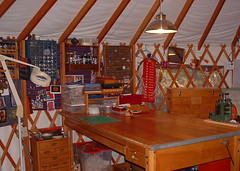Under the Banner of Craft
The basic skills of all of the crafts that I practice, spinning, dyeing, weaving and knitting, can be learned simply and quickly: start by following instructions from a person, a book, magazine or online resource. Then find other practitioners who pass on tips and tricks and a deeper understanding than just "how to"; the "why" of some things. Take some classes. Go to a conference, look at other people's work. Then practice, practice and practice. The practice is what takes the time. Not the learning: that comes in flashes.
The myth that the ease of learning means ease of mastery is false. Mastery takes application, understanding beyond the surface, and understanding of the physical, as well as the aesthetic forces that we are working with. Mastery means an understanding across the spectrum of the craft. There are very few master weavers; it is too broad a field. We tend to specialize.
Mastery also means application over time, and there is no shortcut. 5 years does not a master make, 20 years may not a master make if there is no studious application, no variation of application, no delving into "why", no learning from mistakes, no mistakes made, and no creative solutions to mistakes.
Repeating the same thing over and over makes one a master of that one thing. There are sock knitting masters, for instance, and lace shawl knitting masters, for instance. Many spinners-of-sock-yarns, or dyers of multi-colored tops. These practitioners are not necessarily masters of their whole craft. Yet.
And yet? From the moment we learn, we begin to pass on what we know. The most enthusiastic teachers, are often the beginners: look! at what I found out! We need this enthusiasm. We need these beginners sometimes, to remind us that what we do is fun, most of the time! We need new blood and we need new ideas, people and innovations in passing along the craft. It is such a welcome sight: all these new teachers taking up the banner.

I am working on a series of leather-and-textile bags that will help me perfect my skills. I have taken a few classes, I read online, I have even been to a leather show (!! there are leather shows and there are leather shows, this one was for makers!). Learning this skill means I have to invest the time. Learning this skill means that I don't have as much time for the other crafts that I do: they have been on hold, mentally and physically. When I say mentally on hold, it means that I am forgetting some things. I am not thinking about those things and the process slips back to the back of my mind. I have to dig for the information, and as a teacher that is awkward.
So I am cutting back on teaching. I need time and headspace to practice what I am learning. I will be away from my studio much less. This year, I'll be in North Carolina at Chapel Hill, in Washington State for the Whidbey Spin-in April 1st, and in Pennsylvania at MAFA in July.
That's it. No more! I hope to see some of you at one or another of these venues. The rest of the time?
I'll be here:

The myth that the ease of learning means ease of mastery is false. Mastery takes application, understanding beyond the surface, and understanding of the physical, as well as the aesthetic forces that we are working with. Mastery means an understanding across the spectrum of the craft. There are very few master weavers; it is too broad a field. We tend to specialize.
Mastery also means application over time, and there is no shortcut. 5 years does not a master make, 20 years may not a master make if there is no studious application, no variation of application, no delving into "why", no learning from mistakes, no mistakes made, and no creative solutions to mistakes.
Repeating the same thing over and over makes one a master of that one thing. There are sock knitting masters, for instance, and lace shawl knitting masters, for instance. Many spinners-of-sock-yarns, or dyers of multi-colored tops. These practitioners are not necessarily masters of their whole craft. Yet.
And yet? From the moment we learn, we begin to pass on what we know. The most enthusiastic teachers, are often the beginners: look! at what I found out! We need this enthusiasm. We need these beginners sometimes, to remind us that what we do is fun, most of the time! We need new blood and we need new ideas, people and innovations in passing along the craft. It is such a welcome sight: all these new teachers taking up the banner.

I am working on a series of leather-and-textile bags that will help me perfect my skills. I have taken a few classes, I read online, I have even been to a leather show (!! there are leather shows and there are leather shows, this one was for makers!). Learning this skill means I have to invest the time. Learning this skill means that I don't have as much time for the other crafts that I do: they have been on hold, mentally and physically. When I say mentally on hold, it means that I am forgetting some things. I am not thinking about those things and the process slips back to the back of my mind. I have to dig for the information, and as a teacher that is awkward.
So I am cutting back on teaching. I need time and headspace to practice what I am learning. I will be away from my studio much less. This year, I'll be in North Carolina at Chapel Hill, in Washington State for the Whidbey Spin-in April 1st, and in Pennsylvania at MAFA in July.
That's it. No more! I hope to see some of you at one or another of these venues. The rest of the time?
I'll be here:


3 Comments:
Well spoken. I often stop myself when people ask are you a weaver? a spinner? a knitter? I stop and catch the auto answer I am a _______ . No even with a good number of years under my belt I have to answer I weave or I spin or I knit. I don't consider myself a weaver or spinner or knitter. Maybe because to me those words define a finality to it. With no where else to go because you have gotten there.
Have a wonder filled year Sara I am very excited for you to be taking these steps and embarking on this journey. Good for you!
Thanks for sharing this!
Your comment is everything!
Post a Comment
<< Home